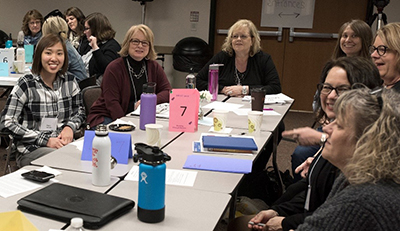By Doug Mack

SWAT members participate in a discussion at the Professional Development Day event in March 2019. Most ERG events and activities over the last two years have been conducted virtually. Photo by Rich Kemp |
With more than 5,000 employees, MnDOT is a large, sprawling team with people of many backgrounds, identities and interests. This diversity and breadth of lived experiences help foster a strong, vibrant workplace built on an array of perspectives and skill sets that go beyond the bullet points listed in a job description.
Employee Resource Groups are a key component in MnDOT’s efforts to recognize, affirm and support diversity, equity and inclusion within the agency, and support employees from traditionally underrepresented communities. Employees from across the agency—in all districts and all types of jobs—currently belong to these groups. The active ERGs include:
- African American Employee Resource Group, for employees who identify as Black, African, African-American, West Indian or of any African descent.
- FUEL - Fully Utilizing Employees without Labeling, which focuses on questions and concerns related to disability issues at MnDOT and in the community.
- Indigenous Employee Resource Group, for employees who identify as Indigenous.
- Q & A –LGBTQQIA2S & Allies, for employees who identify as Lesbian, Gay, Bi, Trans, Queer, Questioning, Intersex, Asexual, or Two Spirit.
- Asian Employee Resource Group, for employees of Asian origin and heritage and from Asian countries.
- Strategic Women Advancing Transportation, a group dedicated to overcoming barriers for women at MnDOT.
- Spectrum, for employees on the autism spectrum and those with family or friends on the autism spectrum.
- Latino-American Employee Resource Group, for employees of Latino heritage.
- Veterans Employee Resource Group, for current military members, veterans and their families.
Employees who identify as allies—people who are not part of the specified background or identity but wish to show their support—are also welcome to join any of the ERGs.
Group members can spend up to six hours per month on ERG-related activities, including a monthly meeting (during the workday) along with professional development, community outreach and other activities. Each ERG works with the Office of Equity & Diversity to develop a specific work plan.
Employees who aren’t in an ERG but are interested in learning more should visit the Employee Resource Groups page on iHUB, which has links to specific information about each group, contacts, upcoming events and frequently asked questions. While some employees may be interested in multiple groups, the Office of Equity & Diversity encourages people to join no more than two, to ensure focused, intentional interaction.
“It’s never too late—or too early—for someone to join an ERG,” said Frida Alvarez, diversity and inclusion organizational development specialist in the Office of Equity & Diversity. “Employee Resource Groups are a place to go to learn (and critique) the work culture, meet new colleagues and be a part of an innovative community committed to diversity, equity and inclusion at MnDOT.” |



